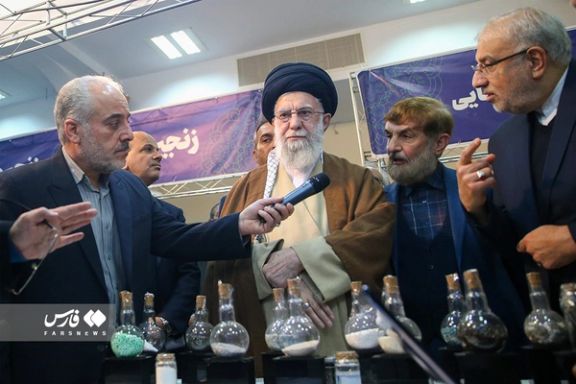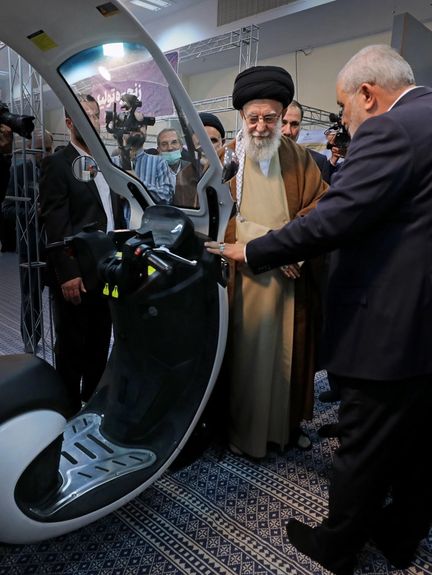Rial Hits Record Low Despite Khamenei's Push To Boost Morale

Amid worsening economic conditions, Iran’s Supreme Leader has moved to lift the spirit of the country’s lackluster industries, meeting businesspeople and touring an expo.

Amid worsening economic conditions, Iran’s Supreme Leader has moved to lift the spirit of the country’s lackluster industries, meeting businesspeople and touring an expo.
In a meeting with approximately a thousand business people and leading industrialists on Tuesday , Ali Khamenei underscored the pivotal role of the private sector in realizing Iran's major economic objectives, pressing for government backing, especially in removing obstacles to business.
Almost all industrial sectors of the country, including oil, gas, petrochemicals, auto manufacturing and banking systems are owned and governed by state entities. Khamenei claimed that the country’s economy is under “supervision of the government, which is different from intervention.” “This supervision is absolutely not subject to compromise," he underlined.
Khamenei’s meeting took place a day after he visited an “exhibition of Iran’s domestic production capabilities.” Unlike similar events that are normally held in designated fairgrounds, the event was held in a bunker at Khamenei’s residence, the so-called Imam Khomeini Hussainia, prompting a lot of Iranians to mock it online. “The exhibition we had the opportunity to visit was very inspiring and important. I believe this exhibition was a showcase of the scientific and technological prowess of the country,” Khamenei said Tuesday.

According to a report by Iran's leading economic newspaper Donyaye Eghtesad (World of Economy) earlier in January, production-related issues such as raw material shortages and difficulties in securing foreign currency have led to the suspension of many production units, pushing the manufacturing industry further into decline.
Soaring inflation, reduced consumer purchasing power, and a decline in demand for intermediate goods, also known as producer goods or semi-finished products, coupled with the government’s contractionary approach to the industrial sector and its interventions, have exacerbated the downturn in sales.
Despite the national currency rial hitting unprecedented lows due to escalating tensions in the Middle East and the potential for a US military clash with Iran as well as the prospect of Donald Trump winning the US presidency, Khamenei continues to outwardly retain an air of optimism. He expressed confidence that despite obstacles such as sanctions and unemployment, the Iranian economy has made substantial progress.
He emphasized that the private sector has the potential to propel Iran toward achieving the targeted 8% growth outlined in its seventh five-year plan. Conversely, the World Bank reported the outlook for Iran's GDP growth as 2.9% in 2022, 2.2% in 2023, and 1.9% in 2024.
The rial hit an all-time low on Tuesday amid fears of US retaliation for a drone attack over the weekend that killed three American servicemen in Jordan. The US dollar rose to nearly 600,000 rials, the highest since February 2022, when it briefly traded at that level.The Iranian currency, which has steadily lost value since the 1979 revolution, has fallen about 13-fold since 2018, when then-president Trump pulled the United States out of the 2015 JCPOA nuclear deal and imposed sanctions on Iran’s oil exports and international banking. Since then, the dollar rose from 42,000 rials to more than 580,000. Before the establishment of the Islamic Republic in 1979, the dollar traded at 70 rials.
On Tuesday, as the devaluation of the rial gained momentum, Iran International learnt that currency exchange offices in Tehran are now forbidden from publicly disclosing rates. The market is enveloped in a security atmosphere marked by the presence of plain clothes agents. Many exchange offices opt to abstain from transactions at the government-issued rates, leading them to either shut down or claim insufficient funds for currency exchanges.
Sepehr Khalaji, the Chief of Iran’s Economic Information and Publicity Headquarters, said Tuesday that “the enemy has orchestrated a situation to create economic fluctuations.” In the Islamic Republic's jargon "enemy" is used to refer primarily to the United States and Israel, and sometimes to their allies.
Hardline newspaper Kayhan, Khamenei’s mouthpiece, also claimed Tuesday that “the exchange rate of the dollar is determined by several Telegram channels outside the country and some channels affiliated with those foreign entities within the country,” once more falling back on foreign influence for the country's decline.
Iranian authorities consistently exhibit ambivalence about the impacts of international measures on the nation's economy. They often attribute any shortcomings to the actions of the US and its allies while simultaneously asserting that these punitive measures lack substantial efficacy.